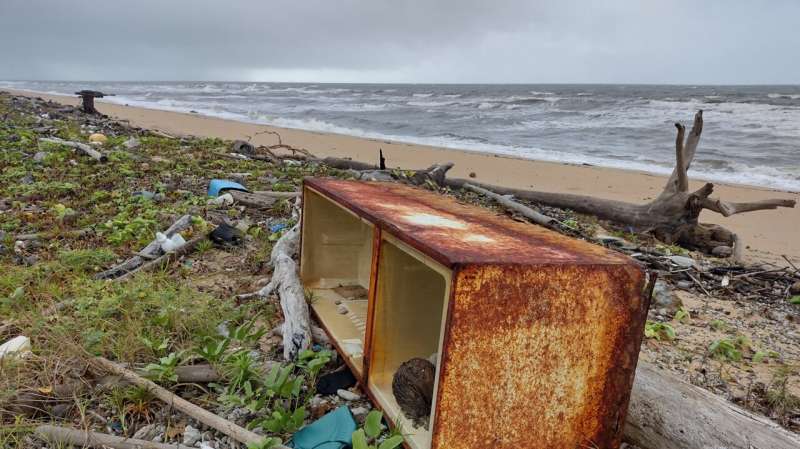This article has been reviewed according to Science X's editorial process and policies. Editors have highlighted the following attributes while ensuring the content's credibility:
fact-checked
peer-reviewed publication
trusted source
proofread
Debris hotspot map can predict dangers for threatened marine life in Australia

A new study has identified the most likely cause of ocean rubbish hotspots in Australia and the risk to four endangered species—green sea turtles, dugongs, Australian sea lions and flesh-footed shearwaters.
Led by the University of the Sunshine Coast, the research team created a "hotspots debris map" using a database of over 24,000 beach surveys of marine and coastal debris, collated by Tangaroa Blue Foundation in the Australian Marine Debris Initiative over ten years.
The entire east coast of Australia experiences constant exposure of debris, according to the study published this week in Global Change Biology, with greater accumulation of rubbish linked to areas with high rainfall, closeness to major ports, mangroves and urban areas.
Lead author and UniSC doctoral candidate Caitlin Smith said the findings revealed several locations around Australia's coastline where threatened species were at risk of exposure to ocean and coastal debris.
"We overlaid this hotspots map with data from four internationally listed threatened species that interact with plastics," Ms. Smith said. "Identifying variables most likely to cause rubbish to deposit on our beaches gives us a better understanding of how to conserve and protect marine life from impacts such as ingestion and entanglement."
Of the four species modeled, dugongs were the most at risk with 5.2% of their known habitat overlapping with debris hotspots.
Green turtles and dugongs are most likely to interact with debris along much of Queensland's eastern coastline, and in Coral Bay, Western Australia. Flesh-footed shearwaters and Australian sea lions are most at risk around the Abrolhos Islands and Perth in Western Australia.
The research team collated coastal debris surveys from Tangaroa Blue Foundation's Australian Marine Debris Initiative Database, collected from their citizen science app from 2012 to 2021. In more remote locations, some surveys were carried out by Tangaroa Blue Foundation's ReefClean project.
Their findings supported previous research that found mangroves are a significant sink for marine debris, and that large ports and urbanized catchments are significant sources for marine debris.
"Hotspots are particularly clustered from the New South Wales south coast all the way up the Queensland coastline," Ms. Smith said.
Perth, Coral Bay and the Albrolhos Islands in Western Australia, and Darwin and toward the Kimberley region in the Northern Territory were areas of concern. As expected, several other major cities showed high abundance of debris, including Hobart, Adelaide and Melbourne.
Ms. Smith said the study highlighted the need for more research into the impact of debris on threatened species, especially sea lions and dugongs.
"Working with species that have very little empirical evidence on their interaction with debris makes it difficult to quantify risk," she said. "Mapping areas of interest gives managers and researchers alike a good starting point from which to conduct surveys or sample the target species to gain a more in depth understanding of debris impacts."
More information: Caitlin E. Smith et al, Predictive modelling reveals Australian continental risk hotspots for marine debris interactions with key threatened species, Global Change Biology (2024). DOI: 10.1111/gcb.17313
Journal information: Global Change Biology
Provided by University of the Sunshine Coast




















